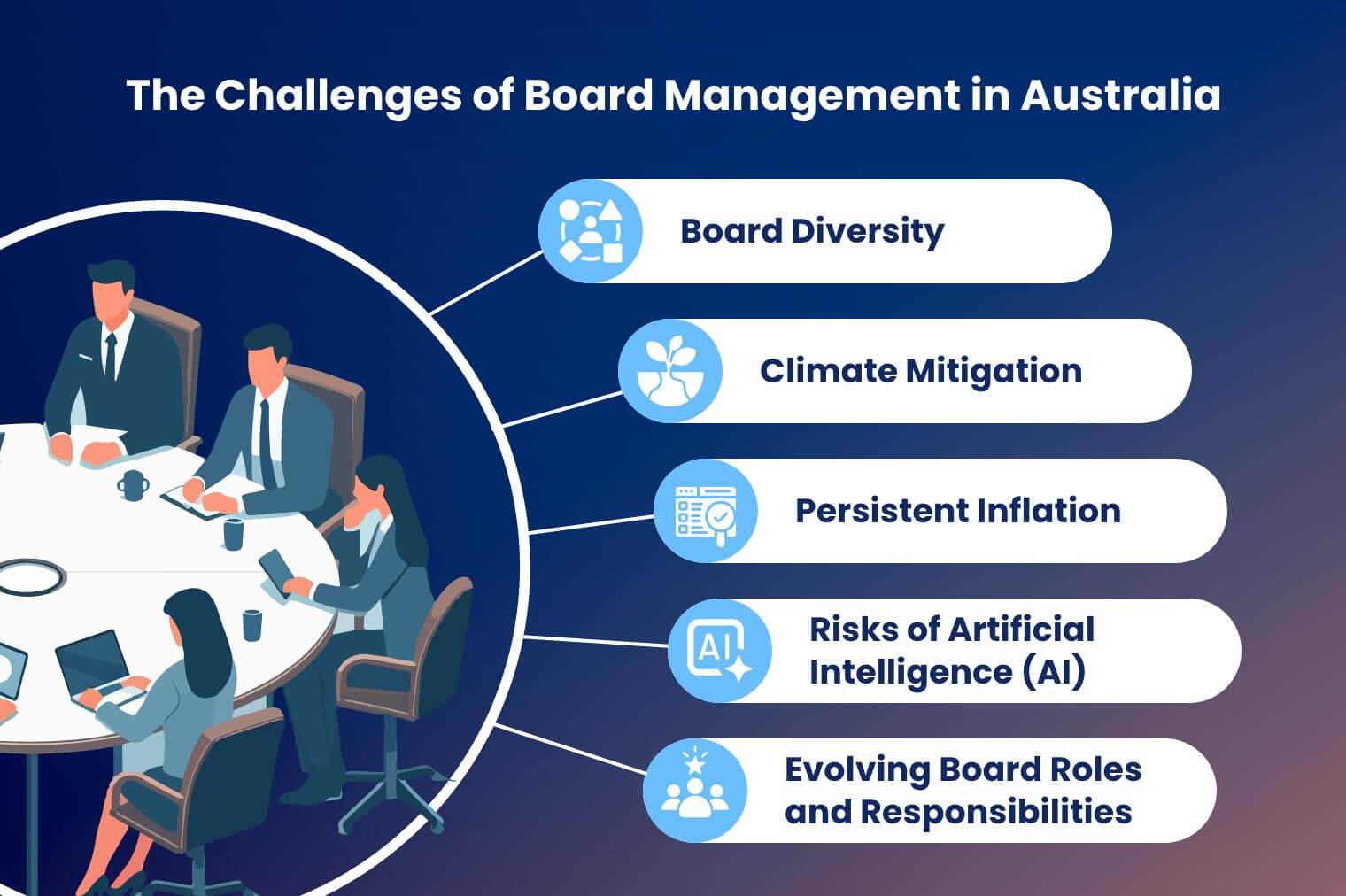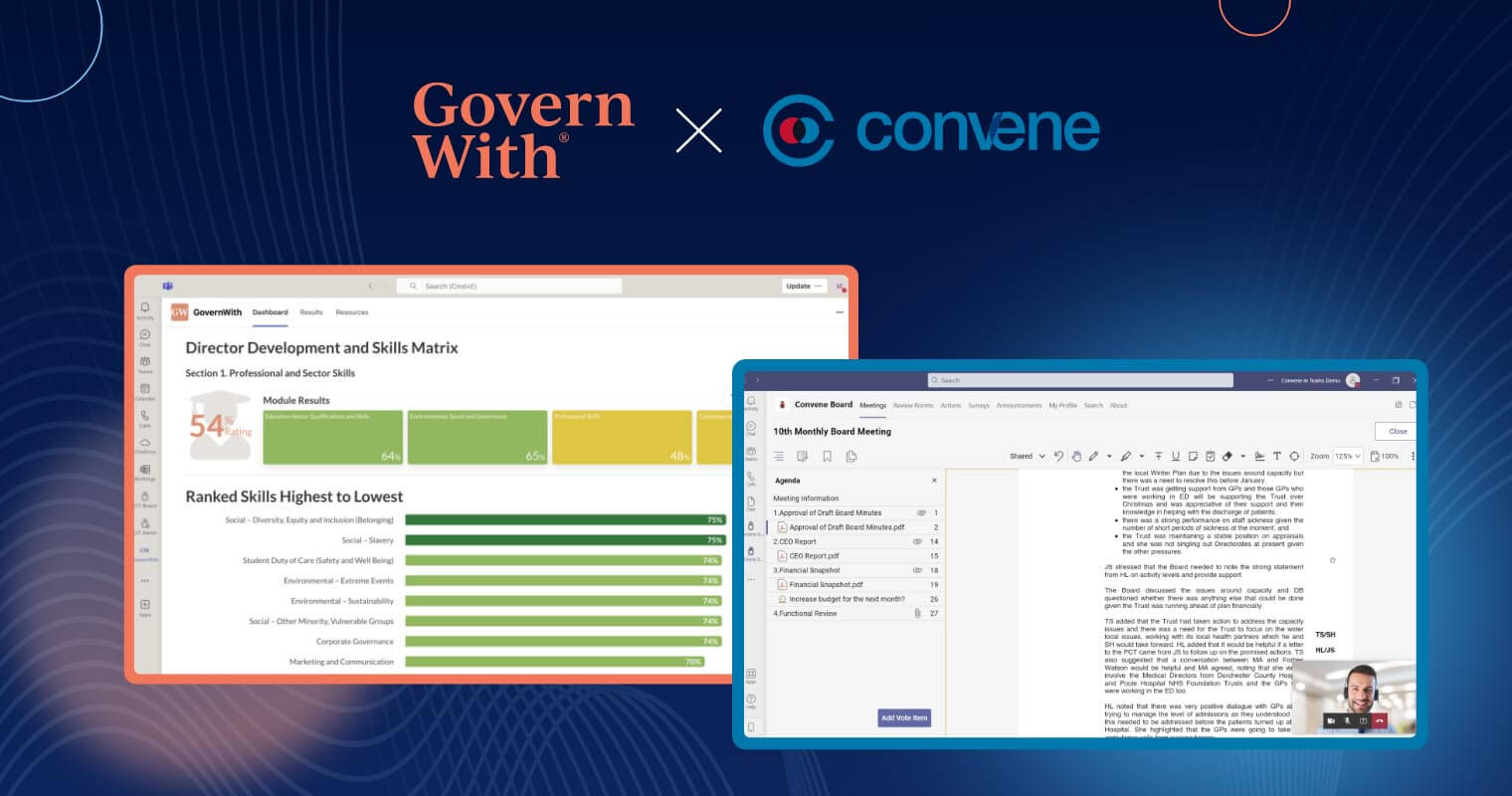Australian boards face intense pressure to fortify corporate resilience amid economic, technological, and regulatory disruptions in 2025.
Shifting Diversity, Equity, and Inclusivity (DEI) policies, exhausting ESG mandates, escalating AI risks, and inflation drive boards to develop more agile and forward-thinking strategies, catalysing board governance transformation nationwide. Alongside these are altering stakeholder demands, which boards must respond to with greater transparency and accountability.
To thrive in a volatile environment, boards must fully understand these challenges and transform them into opportunities. Uncover here the top five board management challenges in Australia in 2025. Gain actionable insights on how to navigate them using modern corporate governance best practices.
State of Board Management in Australia: Challenges and Solutions

Boards must execute decisive and strategic initiatives to guide organisations in times of uncertainty. Here are the pressing challenges that need the board’s expertise in 2025:
1. Board Diversity
Australia has been promoting DEI across boardrooms through the ASX Corporate Governance Policies in recent years. This is why local organisations are increasingly concerned about the reversal of DEI in the United States following the passing of Executive Orders 14151, 14168, and 14173. These developments have prompted global companies to reevaluate their DEI programs, consequently raising questions among Australian boards about their potential implications for corporate policies and workforce morale.
Despite ongoing DEI efforts, the perceived weak impact on board management discourages Australian directors. This has polarised public perception of DEI, further exacerbated by growing anti-sentiments in the US. To meet the new demands of stakeholders, some organisations are reframing their approach with more gender-neutral strategies similar to what US organisations are doing. The impact of the shift on local governance remains unclear, so boards must be proactive on this matter and anticipate repercussions.
What can boards do?
Engage with legal counsel, industry experts, and relevant agencies to understand the nuances of the US policy shift. This helps realign existing DEI programs with potential changes, enabling organisations to remain compliant.
As DEI conversations develop, practice diligent monitoring to capture crucial updates on corporate governance principles from the Australian Securities Exchange (ASX). For example, recent news indicates that the ASX is considering postponing its Fifth Corporate Governance Principles until 2026. This would allow them time to observe how DEI practices settle in the US and to adjust local board diversity reporting policies as necessary.
2. Climate Mitigation
Australia is strengthening ESG initiatives for the future. In September 2024, the parliament passed the Treasury Laws Amendment (Financial Market Infrastructure and Other Measures), which mandates organisations to disclose their climate-related risks and opportunities according to the Australian Sustainability Reporting Standards (ASRS). Aiming to regulate financial reporting, this standard is based on the International Financial Reporting Standards (IFRS) S1 and S2.
The law rolls out in phases, starting this year for Group 1 or entities with 500 or more employees, and will be followed by Group 2 in 2026 and Group 3 in 2027. With its strict timeline, organisations must build ESG systems before their deadlines. This poses a significant hurdle, especially for smaller businesses struggling to allocate resources for necessary ESG investments.
What can boards do?
Build a proactive ESG governance framework that seamlessly blends sustainability initiatives into the core of business operations. Begin by assembling an ESG committee composed of sustainability experts to refine reporting workflows and train relevant leaders. By leveraging their extensive knowledge, boards can streamline governance, risk assessments, and data management, empowering organisations to create consistent and compliant reports.
3. Persistent Inflation
The International Monetary Fund forecasts persistent inflation in Australia throughout 2025. This outlook was echoed by a survey of 300 business leaders who cited increasing operational costs as one of their pressing management challenges this year. Additionally, the National Australia Bank projects a decline in profitability by 12%, subjecting boards to greater pressure to navigate the anticipated market slowdown while maintaining quality outcomes.
What can boards do?
Implement strong financial oversight to generate data-driven insights on cost prioritisation. By conducting audits of financial statements and budget reports, boards will understand their true financial health. This reveals potential risks, allowing more efficient resource allocation.
Integrating technology is another strategy to enhance cost-effectiveness. Using digital tools like board management software, boards can empower teams to optimise workflows across functions such as meeting management, compliance monitoring, and document storage. As a result, this reduces administrative burdens, increasing time for high-impact initiatives.
4. Risks of Artificial Intelligence (AI)
The Tech Council of Australia ranked AI as the top technological trend of the year. Its transformative impact encourages organisations to adopt AI-driven technologies like generative AI, machine learning, and predictive analytics. This enables boards to scale operations more efficiently, resulting in streamlined day-to-day processes and increased productivity.
Despite its explosive growth, boards must not neglect the complicated risks associated with AI, such as data handling, cybersecurity, AI biases, and regulatory compliance. One of the most significant data governance challenges boards face is ensuring AI systems comply with ethical and legal frameworks while maintaining data integrity and security.
Although Australia doesn’t yet have specific AI regulations, it has introduced voluntary policies, such as the Voluntary AI Safety Standards and AI Ethics Principles, to encourage responsible AI usage. Additionally, the parliament is reforming the Australian Consumer Law to ensure the safety of AI-powered products and services. Ultimately, planning and integration require significant resources, which is something boards must execute with careful oversight.
What can boards do?
Establish an AI ecosystem anchored on corporate governance best practices and sustainability frameworks to ensure responsible usage and compliance. Key steps include developing AI literacy programs, conducting AI audits, enforcing data governance and policies, and investing in secured deployment. By taking these measures, boards can effectively mitigate risks and unlock opportunities to create more value.
In the context of national frameworks, Australia’s Eight Artificial Intelligence Ethics Principles promote responsible design, development, and implementation of AI. Under this, organisations should uphold the principles of human, societal and environmental well-being, human-centred values, fairness, privacy protection and security, reliability and safety, transparency and explainability, contestability, and accountability.
5. Evolving Board Roles and Responsibilities
Board roles have expanded over the years due to digitalisation, ESG, changing stakeholder expectations, and regulatory scrutiny. The interplay of these aspects requires directors to be experts in strategic thinking and business planning to create value in the long term.
However, according to a KPMG survey, 42% of 120 Australian board leaders think changing expectations negatively impacts their governance and oversight due to rising accountability, liability, and regulatory responsibilities.
The challenge of evolving board roles and skills is not exclusive to Australia. These factors are prompting boards worldwide to prioritise talent development and succession planning. To remain competitive, they must adapt their structure and roles to fulfil these evolving demands and ensure long-term organisational success.
What can boards do?
Navigating the evolving board roles involves several key areas. Firstly, it’s crucial to promote continuous learning to keep the board abreast of market changes. This can be achieved by offering educational programs, adopting technology, and expert-led briefings to enhance strategic capabilities and industry knowledge.
Secondly, refine governance frameworks to ease pressure from rising accountability concerns. Facilitate regular board benchmarking and assessment to identify strengths and weaknesses, informing board restructuring, recruitment and training plans. Thirdly, enhance talent development by mentoring future directors on adapting to evolving markets, equipping them to drive sustainable growth.
Lastly, consider integrating board management software Australia to consolidate key governance processes in one system. With functions such as document review, e-signature, and annotations, boards can communicate in real time, allowing faster decision-making and a more agile response to market shifts. Board management software Australia strengthens oversight and strategic planning, which helps boards effectively navigate evolving board governance complexities and mitigate data governance challenges.
Top Board Priorities for Australian Companies in 2025

Understanding what the are challenges of corporate governance in Australia in 2025 is only the first step. To overcome them, placing digitalisation, cybersecurity, ESG, board meeting practices, and stakeholder engagement on the board agenda is equally important for adopting corporate governance best practices.
Recognising the urgency of the board management challenges, directors are focusing on:
Driving digital transformation
Boards are leading digital transformations to modernise governance and enhance effectiveness. They are prioritising digitalisation, with 84% of businesses already implementing digital initiatives to streamline operations, control rising costs, and optimise the workforce.
Board management software, AI, data analytics, automation, and cloud computing are among the advanced solutions boards utilise to transform traditional governance. They aim to overcome rigid communication systems, decentralised data management, and disjointed risk management.
Enhancing cybersecurity measures
A report revealed that 71% of Australian board members believe generative AI exposes their organisations to greater material risks. As AI catalyses the widening threat surface in the country, boards are taking more proactive cybersecurity and data privacy measures.
In 2025, organisations are heavily investing in advancing threat detection and response systems to identify anomalous activities and preempt breaches. Moreover, they are establishing comprehensive frameworks to enhance overall resilience. This includes mandatory cybersecurity training, transparent data handling practices with providers, and robust incident response.
Recognising the need for stronger risk management, boards are adopting the Zero Trust approach. This cybersecurity philosophy assumes no trust in the IT infrastructure, encouraging continuous audits and risk mitigation.
Modernising board collaboration
Australian boards are boosting director engagement to facilitate more informed and sound decision-making in 2025. By adopting digital platforms, such as board management software, it’s much easier to foster open communication across the board, remotely or in-person. This helps maximise directors’ diverse backgrounds and skill sets, enabling constructive dialogue and effective planning.
Along with defining communication channels, board management software offers smart features that simplify meeting preparation, secure enterprise document sharing, and enhance post-meeting task follow-ups. Collectively, these tools are designed to strengthen the collaboration of modern boards, resulting in timely and data-driven decisions.
Board management software also helps boards, executives, and subcommittees build high-performing teams. Its tailored governance review and development programs enable leaders to conduct transparent and systematic board evaluations and assessments. By identifying governance gaps, directors can proactively adapt to evolving skill requirements, resulting in a future-ready and effective board.
Ensuring ESG compliance
Organisations demonstrate their commitment to ESG with robust reporting mechanisms to comply with the ASRS and meet stakeholder demands. Boards and their sustainability committees employ digital tools to scale their ESG operations, allowing them to streamline the tracking of environmental impact, supply chain monitoring, data analysis, and report writing.
Establishing innovative ESG processes provides accurate data interpretation, empowering them to form data-driven decarbonisation strategies that meet international best practices. On the governance and social aspect, boards are developing stronger oversight to ensure corporate governance best practices, DEI, and a strong culture of accountability.
Building stakeholder trust
The high-profile corporate scandals in 2024 led stakeholders to demand greater transparency and accountability from boards and senior executives. This compelled boards to move past compliance and foster a genuine corporate culture grounded on high ethical standards.
They achieve this by setting the right tone at the top and aligning their actions with the organisation’s desired culture and values. This also involves empowering board committees to provide oversight of culture within their respective scopes.
To understand stakeholder sentiments, boards engage with diverse groups, including employees, customers, investors, and regulators. This strengthens relationships and increases buy-in for future initiatives, uplifting boards’ confidence in decision-making.
Unify and Streamline Board Management with GWCiT

Navigating Australia’s dynamic business landscape requires agility, strategic thinking, and foresight. To stay ahead, boards must reap the benefits of technology to streamline processes, enhance decision-making, and foster greater collaboration.
With GWCiT (GovernWith x Convene in Teams), boards are poised to achieve modern governance, assured compliance, and enhanced efficiency — all within a single, secure platform. Trusted by governance teams, this board management software Australia integrates governance review, board management, and compliance tools in a unified solution, eliminating multiple logins and providing real-time insights for directors, secretaries, and senior executives.
Adopting GWCiT presents multiple benefits, including:
- Centralised Governance – Experience seamless access to board documents, compliance resources, contemporary governance evaluations, and development plans within Microsoft Teams. Provide decision-makers access to pertinent information anytime, anywhere, with any device.
- Enhanced Collaboration – Drive better decision-making with real-time governance features, such as in-app annotations, live voting, and videoconferencing, enabling uninterrupted communication between leaders.
- Robust Security – Protect sensitive information with Microsoft Teams’ advanced encryption, multi-factor authentication, and user-based controls.
Take your Board’s governance to the next level with GWCiT—the future of contemporary governance, compliance, and leadership. Contact our team today to book a free demo!
Jean is a Content Marketing Specialist at Convene, with over four years of experience driving brand authority and influence growth through effective B2B content strategies. Eager to deliver impactful results, Jean is a data-driven marketer who combines creativity with analytics. In her downtime, Jean relaxes by watching documentaries and mystery thrillers.




